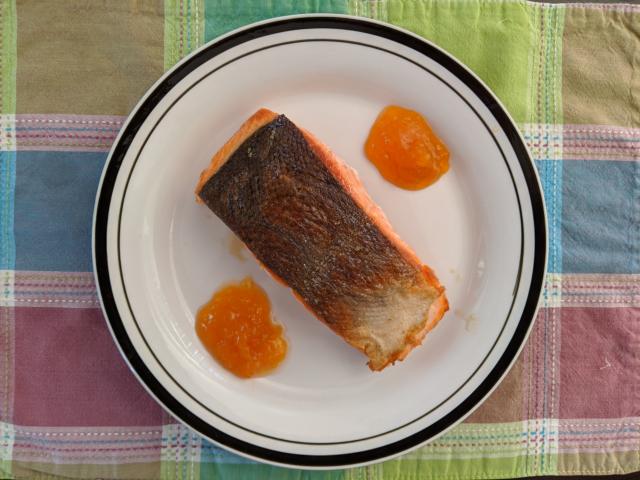Crispy Salmon
I like my salmon fillets skin-on and crispy on both the skin side and flesh side. This can be difficult to achieve while also avoiding overcooking or getting the skin stuck onto the pan. I’ve found a few key key tricks to help achieve this:
-
Use enough cooking fat. I use duck fat for extra flavor, but any high-temperature oil should do.
-
Pat dry both sides of the salmon. Rub salt on both sides immediately before placing into the pan.
-
Make sure the pan is sufficiently hot before adding the salmon. I use a cast-iron pan for heat retention, and let it heat up for at least 5-6 minutes on medium-high heat. I then add the cooking fat and let that heat up for an additional minute. The timings for your cooktop may differ.
-
Once the salmon fillet is in the pan, it will immediately try to curl up. Press down using a flexible metal spatula to counteract this. A metal spatula is also the best tool for getting under the salmon.
-
Cook on both sides to achieve the crispy crust, then transfer to the oven to bring the center to temperature.
To keep the center soft and juicy, I suggest doing a quick brine of the fillet in salted water. This is optional, but leads to better texture and appearance while only adding an extra 15 minutes.
I’ve made this recipe with king salmon (my favorite) and with steelhead trout. I like to accompany this with a bed of rice, roasted vegetables, and one of a variety of sauces. I’ve included a few possibilities below. Always serve the sauce on on the side to ensure the it doesn’t turn the crispy fillet soggy. A fruit jam (like Blenheim apricot jam or blueberry jam) or hoisin sauce can work too.

Ingredients
-
King salmon or steelhead trout fillet, about 1 inch thick in the center
-
Duck fat (optional, you can use a neutral high-temperature oil like avocado oil instead)
-
Brine (optional)
-
Enough water to fully submerge the fillet
-
1 tbsp kosher salt per cup of water
-
-
Kosher salt, to taste
Soy-scallion sauce
-
"Dumpling sauce" (or a mixture of soy sauce, sesame oil, and rice vinegar)
-
2 green onions, chopped and briefly sauteed in the above sauce
Soy-apricot jam
-
3 parts apricot jam
-
2 parts soy sauce
Hot sauce crema
-
Creme fraiche
-
Your favorite hot sauce, to taste (mine is garlic lime Cholula)
Directions
-
(Optional) Dissolve 1 tbsp kosher salt per cup of water in a container wide and deep enough to fit the whole fillet. Add the fillet, ensuring it is fully submerged. Brine for 15 minutes.
-
Preheat the oven to 300 degrees. Press dry both sides of the salmon fillet with paper towels.
-
Preheat a cast iron skillet on medium-high heat for at least 5-6 minutes. Water droplets should immediately sizzle and evaporate on contact when it is hot enough.
-
Add duck fat to the skillet and allow the fat to heat up for at least a minute. Meanwhile, generously salt both sides of the salmon fillet. Do this immediately before putting it in the pan.
-
Carefully place the salmon into the skillet skin-side up and cook for at least 5 minutes. For the first 30 seconds to a minute, use a fish spatula to gently press down on the fillet to ensure even contact of the flesh with the pan.
-
From the side, you should start to see a brown crust forming in the bottom 1-2mm of the fillet. Use a fish spatula to get underneath the flesh side. It should be crispy and release easily. If not, leave it alone and let it continue to cook, checking again every 30 seconds.
-
Carefully flip the fillet to the other side (skin-side down) and cook for 2 minutes. For the first 30 seconds to a minute, use a fish spatula to gently press down on the fillet to ensure even contact of the skin with the pan.
-
Move the salmon to the oven and allow it to cook to the desired internal doneness, about 3-5 minutes depending on the oven and the thickness of the fillet.
-
Plate the salmon and serve with sauce on the side, not on top or bottom.
Notes
-
Cooking the fillet can get messy in terms of oil splatter, so a splatter guard may come in handy. Make sure it doesn’t trap moisture, which would make it harder to achieve crispiness.